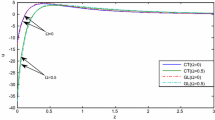Abstract
We investigate the effect of rotation on plane wave propagation in a half-space of a piezo-thermoelastic material within the frame of dual-phase-lag model. Normal mode technique is used to obtain analytic expressions for the displacement components, temperature and stress components. Numerical results for the quantities of practical interest are given in the physical domain and illustrated graphically. Comparison is carried out between the results predicted by the dual-phase-lag model and Lord–Shulman theory, in the presence or absence of rotation. It is believed that the present results may be useful in the design and construction of different pyro/piezoelectric devices, such as gyroscopes and sensors.



















Similar content being viewed by others
Abbreviations
- \(u_{i}\) :
-
The mechanical displacement
- T :
-
Absolute temperature
- \(\sigma _{ij}\) :
-
Stress tensor
- \(E_{i}\) :
-
Electric field
- \(C_{ijkl}\) :
-
Elastic stiffness tensor
- \(\in _{ij}\) :
-
The dielectric moduli
- \(\tau _{\theta }\) :
-
Phase lag of temperature gradient
- \(K_{ij}\) :
-
Heat conduction tensor
- \(C_{T}\) :
-
Specific heat at constant strain
- \(\alpha _{1} ,\alpha _{3}\) :
-
Coefficients of linear thermal expansion
- \(v_{p}=\sqrt{\frac{1}{\rho }C_{11}}\) , :
-
Longitudinal wave velocity
- \(\varphi\) :
-
Electric potential
- \(\varepsilon _{ij}\) :
-
Strain tensor
- \(\beta _{ij}\) :
-
Thermoelastic tensor
- \(D_{i}\) :
-
Electric displacement
- \(e_{ijk}\) :
-
Piezoelectric tensor
- \(p_{i}\) :
-
Pyroelectric moduli
- \(\tau _{q}\) :
-
Phase lag of the heat flux
- \(T_{0}\) :
-
Reference temperature
- \(\rho\) :
-
Mass density
References
Abbas IA, Zenkour AM (2014) Dual-phase-lag model on thermoelastic interactions in a semi-infinite medium subjected to a ramp-type heating. J Comput Theor Nanosci 11(3):642–645
Abd-Alla AN, Alsheikh FA (2009) Reflection and refraction of plane quasi-longitudinal waves at an interface of two piezoelectric media under initial stresses. Arch Appl Mech 79(9):843–857
Abou-Dina MS, Dhaba EL, Ghaleb AF, Rawy EK (2017) A model of nonlinear thermo-electroelasticity in extended thermo-electroelasticity in extended thermoelasticity. Int J Eng Sci 119:29–39
Ahmed EAA, Abou-Dina MS, El Dhaba AR (2019) Effect of gravity on piezo-thermoelasticity within the dual-phase-lag model. Microsyst Technol 25:1–10
Alshaikh FA (2012) The mathematical modelling for studying the influence of the initial stresses and relaxation times on reflection and refraction waves in piezothermoelastic half-space. Appl Math 3:819–832
Ciesielski M (2017) Analytical solution of the dual phase lag equation describing the laser heating of thin metal film. J Appl Math Comput Mech 16(1):33–40
Hou PF, Leung AYT (2009) Three-dimensional Green\(^{\prime }\)s functions for two-phase transversely isotropic piezothermoelastic media. J Intell Mater Syst Struct 16(5):1915–1923
Kumar R, Sharma N, Lata P, Marin M (2018) Reflection of plane waves at micropolar piezothermoelastic half-space. CMST 24(1):113–124
Li L, Wei PJ (2014) The piezoelectric and piezomagnetic effect on the surface wave velocity of magneto-electroelastic solids. J Sound Vib 333(8):2312–2326
Mahmoud SR (2016) An analytical solution for the effect of initial stress, rotation, magnetic field and a periodic loading in a thermoviscoelastic medium with a spherical cavity. Mech Adv Mater Struct 23(1):1–7
Mindlin RD (1974) Equations of high frequency vibrations of thermo-piezo-electric plate. Int J Solids Struct 10:625–637
Othman MIA (2004) Effect of rotation on plane waves in generalized thermoelasticity with two relaxation times. Int J Solids Struct 41:2939–2956
Othman MIA, Ahmed EAA (2015) The effect of rotation on piezo-thermoelastic medium using different theories. Struct Eng Mech 56(4):649–665
Othman MIA, Ahmed EAA (2016) Influence of the gravitational field on piezo-thermoelastic rotating medium with G–L theory. Eur Phys J Plus 131:1–12
Othman MIA, Elmaklizi YD, Ahmed EAA (2017) Influence of magnetic field on generalized piezo-thermoelastic rotating medium with two relaxation times. Microsyst Technol 23(12):5599–5612
Othman MIA, Hasona WM, Eraki EEM (2013) Influence of gravity field and rotation on a generalized thermoelastic medium using a dual-phase-lag model. J Thermoelast 1(4):12–22
Othman MIA, Hasona WM, Eraki EEM (2014) Effect of rotation on micro-polar generalized thermoelasticity with two-temperatures using a dual-phase-lag model. Can J Phys 92(2):149–158
Quintanilla R, Racke R (2006) A note on stability of dual-phase-lag heat conduction. Int J Heat Mass Transf 49:1209–1213
Roy Choudhuri SK (2007) One-dimensional thermoelastic waves in elastic half-space with dual phase lag effects. J Mech Mater Struct 2(3):489–503
Schoenberg M, Censor D (1973) Elastic waves in rotating media. Q Appl Math 31:115–125
Sharma JN, Kumar M (2000) Plane harmonic waves in piezo-thermoelastic materials. Indian J Eng Mater Sci 7:434–442
Singh B, Kumari S, Singh J (2017) Propagation of Rayleigh wave in two temperature dual phase lag thermoelasticity. Mech Mech Eng 21(1):105–116
Author information
Authors and Affiliations
Corresponding author
Additional information
Publisher's Note
Springer Nature remains neutral with regard to jurisdictional claims in published maps and institutional affiliations.
Appendices
Appendices
1.1 Appendix A
and
1.2 Appendix B
Rights and permissions
About this article
Cite this article
Ahmed, E.A.A., Abou-Dina, M.S. & Ghaleb, A.F. Plane wave propagation in a piezo-thermoelastic rotating medium within the dual-phase-lag model. Microsyst Technol 26, 969–979 (2020). https://doi.org/10.1007/s00542-019-04567-0
Received:
Accepted:
Published:
Issue Date:
DOI: https://doi.org/10.1007/s00542-019-04567-0




